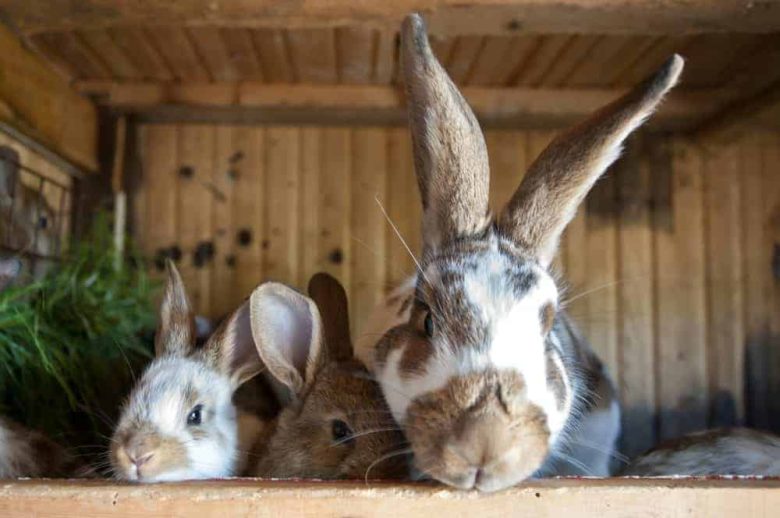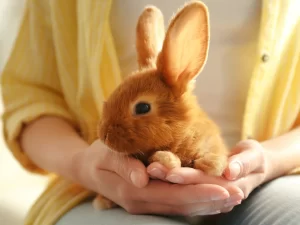The gentle nature and cute appearance of rabbits make them wonderful animals. Allowing them to enjoy the outdoors can greatly improve their health, although they make excellent adult pets. But if you want your rabbit to feel safe and comfortable outdoors, you need to plan and pay attention to his special needs. This guide covers the most important things you need to do to keep your rabbit happy outdoors.
1. Security Container:
The most important thing to consider when releasing your rabbit outdoors is a safe hiding place. Rabbits are naturally good at digging but are also excellent at escaping if given the chance. Choose a sturdy and well-built cage and make sure the bottom is solid or in the ground to prevent the animals from burrowing. Make sure the walls are high enough to prevent rabbits from jumping over them and that there are no holes or holes for rabbits to get through.
A mesh top can help protect your rabbit from potential threats. The top should provide shade and protection from the elements, while still allowing air to flow freely. Always keep an eye on your rabbit when he is outside to make sure he is safe in his cage.
2. Safety and Parasol:
Rabbits cannot tolerate high or low temperatures, so it is important to provide them with shelter and shade. A weatherproof hut or cozy shelter in the area protects the animals from rain, wind, and direct sunlight. Ensure good air circulation to prevent the lid from overheating.
If it is warm outside, place the cage in a shady spot and use a tarp or umbrella for extra shade. In cold locations, make sure the cage is insulated and add extra blankets to keep the rabbit warm. To determine exactly when it is safe for your rabbit to go outside, pay close attention to the weather forecast.
3. Healthy Food and Nutrition:
Whether you keep your rabbit indoors or outdoors, it is important to feed him a healthy, balanced diet. On the other hand, fresh grass and a variety of plants outside can provide more stimulation for your rabbit.
Make sure outdoor areas are free of poisonous plants, pesticides, or chemicals. Allow your rabbit to eat fresh grass that has not been treated with pesticides, but beware of overgrazing, which can cause stomach damage. To ensure they get all the nutrients they need, you can feed them high-quality hay, fresh vegetables, and a small amount of rabbit food while they are out and about.
4. Exercise Regularly:
Running outside is a great way for your rabbit to get the exercise he needs to stay fit and healthy. Place tunnels, toys, and other obstacles in the enclosure so that the animals can move and think. To keep your rabbit interested, rotate and change settings regularly.
Keep an eye on your rabbit while he plays to make sure he doesn’t get hurt or stray outside his safe area. Regular exercise is important to prevent your canine friend from gaining weight and to encourage him to live a happy, active life.
5. Talk to People and Make Friends:
Rabbits are very social animals and enjoy being around people. When your rabbit is outside, talk to it, give it treats, pet it gently, and spend quality time with it. This good behavior will strengthen the bond between you and your rabbit and make him happier overall.
If you have more than one rabbit, make sure they get along well with each other and give each rabbit plenty of space to define its area. Be careful if you bring a rabbit you don’t know, as territorial disputes can turn into fights.
6. Care for Animals:
Every rabbit needs regular visits to the vet, but rabbits that live outside can be more susceptible to insects and disease. Make sure your rabbit is up to date on vaccinations and talk to your vet about ways to keep him healthy. Check your rabbit’s ears, teeth, and coat regularly for signs of illness.
If you notice any changes in your pet’s behavior, appetite, or other physical symptoms, contact your veterinarian immediately. Early detection and treatment of problems can have a major impact on the health and well-being of your rabbit.
7. Keep an Eye on Predators:
Even in a secure environment, you need to be aware of potential attackers. Your rabbit may face threats from raccoons, birds of prey, and even feral cats. Make sure the mesh of the fencing is strong and will not let animals through. Do not leave your rabbit alone for long periods, especially at dawn and dusk when many animals are out hunting.
If your rabbit is showing signs of anxiety or stress, find out why and take the appropriate steps to eliminate any threats. Giving your rabbit a place to hide in his cage can help him feel more secure.
Conclusion
Rabbits need to be carefully planned, kept in a safe place, and have their needs met at all times when outside. You can improve your rabbit’s quality of life by providing him with a safe and fun outdoor space where he can explore, exercise, and interact with the environment. Monitor the weather, make sure your rabbit’s environment is safe, and put his health first to ensure he is safe in his outdoor home.
FAQs
1. Can I leave my rabbit outside all the time?
Although rabbits can benefit from being outdoors, it is also important to provide them with a safe enclosure that is covered and weatherproof. Make sure you keep an eye on your rabbits when they are playing outside, and if the weather is really bad, bring them inside to ensure their safety and health.
2. What type of shelter is best for outdoor rabbits?
Choose a sturdy cage with solid or recessed walls, a solid or recessed bottom, and a mesh top to promote air circulation. Make sure there is plenty of room for your rabbit to run around and that there is a covered area to protect him from the elements.
3. How do I protect my rabbit from other animals that want to eat it?
Use sturdy mesh to protect against predators and do not leave your rabbit alone for long periods. Be careful at dawn and dusk, when man-eating animals are busiest. Giving your rabbit places to hide in the cage can also help him feel safer.
4. Can I let my rabbit graze outside on the grass?
If the grass is green and free of pesticides, rabbits can eat it. But keep an eye on them while grazing so they don’t overeat, which can lead to stomach problems. Make sure open spaces are free of poisonous plants, pesticides, or chemicals.
5. What should I do if the weather is particularly bad?
If it is warm outside, place the cage in a shady spot and use a tarp or umbrella for extra shade. In cold locations, make sure the cage is insulated and add extra blankets to keep the rabbit warm. Always put your rabbit’s happiness and health first.
6. How do you get people to come out and think?
Place tunnels, toys, and other obstacles in the enclosure so that the animals can move and think. To keep your rabbit interested, move and rotate the device regularly. Keep an eye on the playing time to avoid mistakes.


